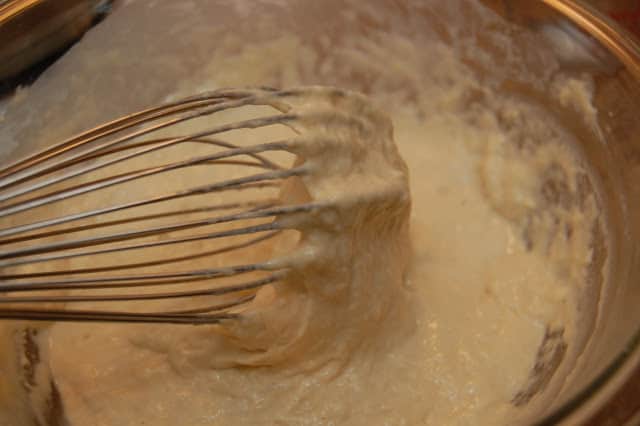 |
| My Grandma Jackie, seventh grade |
“In wine there is wisdom,in beer there is strength,in water there is bacteria.”-German Proverb
I grew up hearing stories about my Great Great Grandma who was German. When I close my eyes, my memories dazzle with all the times my Grandma Jackie would pass on the wisdom of her mother and grandmothers. She is full of pearls like the one above (which actually isn’t one she gave me, but it shares the sentiment of her zingers). The one thing she hasn’t passed down, unfortunately, are German recipes.
Luckily, a few months ago our great CSA farmer shared her own recipe for German spaetzle, and I stashed it away for a later time when Nate was home from his two-month international trip. After all, who wants to make such a hearty, cheesy comfort meal when serving a table of one? No, this is a dish that is made with love and labor, and it is so gluttonous it practically demands being shared.
Incidentally, I find myself having to explain to Nate numerous pop culture references to nursery rhymes and fairy tales over the years, such as my use of Jack Sprat above. Most recently, this week I found myself telling him the story of The Princess and The Pea. Nothing will make you realize more how ridiculous these stories are until you have to describe them from memory. (“Let’s see, there was this princess who was very dainty. No wait, this prince wanted to marry a dainty princess, so he put a pea under a bunch of mattresses to test the princesses.” This is the moment Nate raised a skeptical eyebrow at me.)
Okay, back to spaetzle. As I frequently do prior to cooking something new these days, I first consulted smitten kitchen’s expansive collection to see if she had endeavored to make this dish. Of course she had. I appreciated as always her excellent descriptions and food photography skills. In the end, I opted to use the cutting board/knife method she describes as the Austrian homemaker way. Fine by me!
I loved standing over the pot of water, dropping in bits of dough and imagining my great great grandmother doing the same years ago. That’s the great thing about memory; you can remember what you want and eventually it becomes true to you–meaning I can add this recipe to my collection of heirloom recipes
Spaetzle tastes a bit like a cross between gnocchi and noodles. But it is easier than both! I don’t know why we don’t make them more in our culture; it’s the cheap and easy way to starchy goodness. Perhaps I just answered my own question, as it seems starch has become the latest “No” food. Wait around a few years, and that will surely change. Until then, I’ll be in my closet, eating my delicious starch.
A note about ingredients: We used Swiss cheese and fresh kielbasa because that’s what we had on hand. It seems to me that with a few ingredient tweaks here and there, this is a recipe with endless scrumptious possibilities.
yummy German spaetzle
serves 4
· 1 pound smoked kielbasa, cut into 3/4-inch chunks (fresh works too – just slice into chunks and brown in a skillet a bit longer)
· 1 1/2 tablespoons unsalted butter
· 1 large Vidalia onion, halved and thinly sliced
· large thyme sprig
· Kosher salt
· 2 1/4 cups all-purpose flour
· 1/4 teaspoon freshly grated nutmeg
· 2 large eggs, lightly beaten
· 3/4 cup whole milk
· 1/2 pound Emmentaler (or Swiss) cheese, grated (2 cups)
· 1/2 teaspoon black pepper
1. In a large skillet over medium-high heat, lightly brown the kielbasa until golden, about 5 minutes. Transfer to a plate. Melt the butter in the skillet. Stir in the onion and thyme, and stir briefly to coat the onion with butter. Cook onion, without stirring, until dark brown, about 5 minutes. Add a pinch of salt and cook on low heat until very soft and caramelized, 20 to 30 minutes. Stir in 2 tablespoons water and scrape up any browned bits from the bottom of the pan. Transfer onion to a bowl.
2. Bring a large pot of salted water to a boil. In a large bowl, combine the flour, 1 teaspoon salt and the nutmeg. In a separate bowl, whisk together the eggs and milk. Pour the egg mixture into the flour mixture and stir well. The batter should be fairly wet, with a consistency slightly thicker than pancake batter.
 |
| Took me a smidgen over 3/4 c. milk to reach “slightly thicker than pancake batter” status |
3. Spread a clean dish towel flat on a work surface adjacent to the stove. Working over the pot of boiling water, press dough through a spaetzle maker or use a rubber spatula to push it through a colander with holes at least 1/4-inch wide (or do it the Austrian homemaker way). Drop dough into the water. When dumplings rise to the surface, use a slotted spoon to transfer to the towel.
{Sorry, no photo. Picture me, sweating profusely, and a few choice swear words}
4. Heat the oven to 375 degF. Toss the spaetzle and kielbasa in the bowl with the onions, and add 1 1/2 cups cheese and the pepper. Spread into a 2-quart gratin dish. Sprinkle the top of the casserole with the remaining 1/2 cup cheese. Bake until golden and bubbling, 25 to 30 minutes. Try not to drool on it.

Editor’s note: This post is part of Sunday School, Simple Lives Thursday, Frugal Days, Sustainable Ways, Real Food Wednesday, Scratch Cookin’ Tuesday, Monday Mania, The Homestead Barn Hop, Fresh Bites Friday, Friday Food Flicks, Farmgirl Friday, Fight Back Friday, and Frugal Friday



